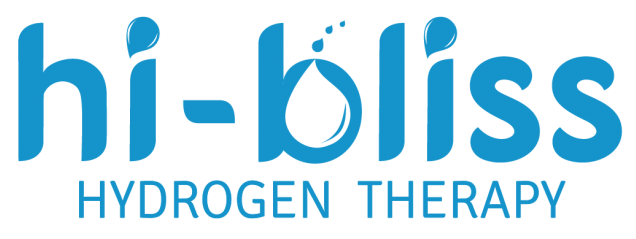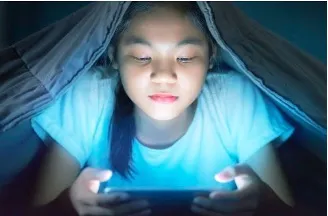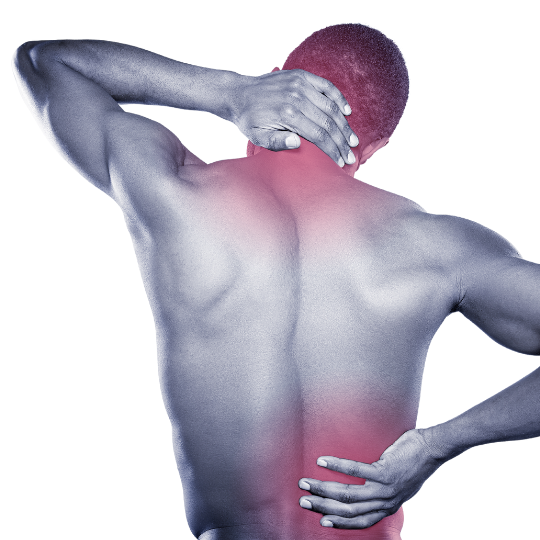Children experience massive, early use of and exposure to all types of screens such as smart phones, computers, tablets, consoles and television. The exposure and interaction with screens has been growing and becoming a real addiction, as per health professionals and early childhood experts in their warning to parents. Tablets and smartphones, are constantly being used to distract kids and keep them quiet, and they are also perceived as educational. This makes screen time hard for kids to avoid.
According to one study, the average child (between the ages of 4 and 14 years of age) spends three hours a day watching TV, and up to seven hours total staring at a screen. Teens recently told Wall Street Journal reporters that they watch YouTube / Tik Tok videos every chance they get. Add video games, TV, phone time with friends, schoolwork, and tablet media consumption and you can rack up a lot of HEV rays or blue light exposure.
A Nielsen study found that 70% of tablet-owning parents of kids under 12 let their children play with the tablets. Common Sense Media found that 30% of toddlers have a TV or tablet in their bedrooms. Kids under one year of age spend twice as much time with electronic devices as they do with books. According to the Ordre des Optométristes du Québec, 20-25% of children between the ages of 5 and 14 have various visual problems requiring treatment by an optometrist. Without realizing this, parents allow their children to be exposed to many risks that can contribute to a number of eye problems or eye troubles.
Your child’s eyes don’t filter blue light as well as yours do. Because children’s eyes have larger pupils and more transparent lenses than adults, light streams into them more freely. (One recent study showed that the transmission of blue light through a 9-year-old’s eye is 1.2-times higher than that of an adult.)
The key for all parents is to fully understand the impact that blue light has on a child's well being, so that proper action can be taken to minimize exposure when it is not entirely necessary.
- Disturb Sleep patterns and the lack of a good night’s sleep
We all need to ensure we get a good night's sleep, but this is especially true for our growing children who are still developing and rely on a good night's rest to be able to manage their moods and environment during the day. Poor sleep quality/ disrupted sleep patterns may mean that your child’s concentration levels are lower during the day. Blue light is proven to disturb sleep patterns, which results in the accelerated production of cortisol and releases melatonin even more slowly than it does yours.
- Learning problems
Poor sleep quality and sleep deprivation have pretty shocking consequences in many areas. It's linked to reduced learning capacity and poor academic performance.
- Hormonal Effects
Blue light stimulates your brain, slowing or stopping release of the sleep hormone melatonin. That makes it harder to get a good night’s sleep," and this generally messes with a child's hormonal patterns. A 2016 study on children of preschool age found that higher artificial light exposure from their environment contributed to an increased BMI and increases the long-term risk for developing obesity. There is also evidence that disruption of the circadian rhythm may be connected with diabetes, obesity, and heart disease.
- Mental health / disorders
Moods can be altered, and this may effect behavior as a whole. Exposure to blue light at night can lead to the over-production of "adrenaline, dopamine, serotonin and cortisol," and these can be strongly connected to a series of mental disorders and attention focusing issues. Best Health Mag states that Insomnia / sleep loss is among the leading causes of a series of mental disorders:-
- Anxiety: Such instances of poor sleep quality may lead to increased stress levels, which in turn trigger seemingly inexplainable anxiety issues in children. This can present itself through temper tantrums or confrontational behavior.
- Depression: Children of all ages already have a lot going on. Their environments are often so full of stimulation that they already express difficulty processing everything. It is reported that about three quarters of people with depression have sleep disturbances.
- ADHD: According to a recent study, 1 in 10 children will be diagnosed with ADHD, and this is directly related to their exposure to blue light. ADHD has a significant effect on a child's mental development and also has lasting effects on their ability to perform well at school and function at a normal level with their peers.
- Digital Eye Strain
Digital eye strain happens when a lot of time is spent using near vision, for example, reading on screen or playing online games. Digital eye strain does not cause permanent damage to your eyes but can be uncomfortable. Evidence suggests that carrying out near tasks, involving looking at something close-up, such as using mobile devices, screen time and reading a book, can increase eye strain for those who do this for long periods of time. It increases the chances that a child will become astigmatic, myopic or hyperopic in adulthood.
One of the main symptoms is temporary blurred vision but other signs such as sore and tired eyes, dry eye and headaches are also associated with digital eye strain.
- Growing Concerns over Risks of damaging the Macula
Children especially, are at particular risk of macular damage from blue light because their eyes are not as efficient at filtering out the rays.
- Short-sightedness or Myopia
Short-sightedness, or myopia, is increasing throughout the world. Family history, ethnic background, environment (living indoors, in cities) and carrying out near tasks, such as screen use, have all been linked to the development of myopia.
- Kids’ Brain Development
In a study, preschoolers ages 3 to 5 whose screen usage was greater than what is recommended by the American Academy of Pediatrics (AAP) completed cognitive testing and brain imaging. Their parents also completed a survey about screen usage. The results revealed that kids with higher screen usage had lower measures of brain structure that support skills such as language and literacy.
Tips for keeping your child’s eyes healthy
- Protect their eyes, by limiting and monitoring your child’s screen time. Toddlers ages 2 to 5 should spend no more than one hour on screens per day. Instead, do something fun and interactive together. Hands-on, unstructured play helps kids’ brains and social skills develop.
- Set a curfew. Have them put all electronic devices, including handheld game devices, away at least one hour before bedtime. Don’t let them take smartphones to bed.
- Maintain a consistent bedtime without big differences across weekdays and weekends.
- Establish a calm and consistent pre-bedtime routine.
- Reduce light levels in the home at least one hour before bedtime.
- Ensure that the sleeping environment is at a comfortable temperature without disruption from light or noise.
- Create a central charging station away from bedrooms. Everyone (yes, even you!) has to plug in there at night.
- Plan media-free times for all ages. No screens while doing homework, eating a meal or during family time.
- Make sure children get enough natural light during the day.
Recommendations from optometrists and opticians, based on the age of the child:-
- Before the age of 2
According to some studies, before the age of 2, non-interactive screens such as those used for television and DVDs have only negative effects. They can cause visual disturbances, weight gain, delayed language, a lack of concentration and attention, and should therefore be avoided for infants.
- From ages 2 to 3
At this age, children need to build their temporal and spatial guidelines hence, good vision is extremely necessary. Between 2 and 3 years of age, exposing children to television in a passive and prolonged way and without an interactive, educational human presence is strongly discouraged.
From the age of 3, screens help children to distinguish between the real and the virtual. They will be able to copy and imitate what they see. However, they should not spend more than 1 hour per day in front of a screen (all devices combined).
- From 4 to 6 years of age
Between the ages of 3 and 6, a child needs to develop all of his manual and sensory possibilities hence the programs and applications chosen must be of high quality. It is also recommended that parents are present in order to explain what their child is seeing and how it applies to the world around them. Again, it is recommended that children not exceed 1 hour of screen use per day.
- From 6 to 12 years of age and older
Between 6 and 10 years of age, it is important for the social development of the child to be established hence it is best to set a certain amount of screen time per day so that the child can discover social gaming and involve themselves with others.
From 9 to 12 years of age, children need to explore the world and its complexity.
From the age of 12, parents must monitor possible nighttime screen use because it can be harmful. Good use of these screens allows an adolescent to improve control over emotions and thoughts, actions and decisions.
However, excessive use of screens and especially the Internet can reduce memory as well as the ability to synthesize the personal and consciousness. It also causes drowsiness, difficulty concentrating and eye problems. Vision is essential to a child’s learning experience and this can be reflected in academic performance, when one observes a decline.
Hydrogen’s protective effects includes its potent antioxidant properties selectively scavenges free radicals thus reducing oxidative stress, and anti-inflammatory properties effectively reduces inflammation. Learn more how Hi-Bliss Hydrogen Therapy can help to take care of your eyes here: https://hi-bliss.com/skin-eyecare-programs/
References:-
- Protective effect of saturated hydrogen saline against light-induced retinal damage in rats ~ Mei Feng, Xing-Hua Wang, Xiao-Bo Yang, et al. | Int J Ophthalmology | doi: 10.3980/j.issn.2222-3959.2012.02.07 | https://www.ncbi.nlm.nih.gov/pmc/articles/PMC3359028
- An Immunohistochemical Study of the Increase in Antioxidant Capacity of Corneal Epithelial Cells by Molecular Hydrogen, Leading to the Suppression of Alkali-Induced Oxidative Stress ~ C. Cejka, J. Kossl, B. Hermankova, V. Holan, and J. Cejkova, et al. Oxidative Medicine And Cellular Longevity | Volume 2022 | Article ID 9846572 | DOI:10.1155/2020/7435260
- Rapid Diffusion of Hydrogen Protects the Retina: Administration to the Eye of Hydrogen-Containing Saline in Retinal Ischemia-Reperfusion Injury ~ Yaxing Zhanga Sihua Tana et.al. Cell Physiol Biochem 2018;47:1-10. DOI: 10.1159/00048973
- Sirtuin Type 1 Mediates the Retinal Protective Effect of Hydrogen-Rich Saline Against Light-Induced Damage in Rats ~ Lin-Song Qi; Lu Yao; Wei Liu; Wei-Xun Duan et. al. Investigative Ophthalmology & Visual Science December 2015, Vol.56, 8268-8279. https://doi.org/10.1167/iovs.15-17034



